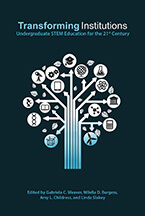Purdue Press publishes book by Discovery Park research center on transforming STEM learning for undergraduates
November 24, 2015
 |
WEST LAFAYETTE, Ind. - Higher education's ability to prepare students to compete in the 21st century workplace faces increasing scrutiny.
Existing and ingrained structures of higher education, particularly in the science, technology, engineering and mathematics (STEM) fields, are not set up to provide the skill development in three key areas necessary for student success in the knowledge economy: communication, teamwork and divergent thinking, a new book published by Purdue University Press suggests.
Addressing this issue by formulating solutions within diverse academic settings is the focus of "Transforming Institutions: Undergraduate STEM Education for the 21st Century." Edited by Gabriela C. Weaver, Wilella D. Burgess, Amy L. Childress and Linda Slakey, the book brings together chapters from the scholars and leaders who were part of the 2011 and 2014 conferences led by the Discovery Learning Research Center in Purdue's Discovery Park.
"Central to the issue of institutional transformation is the ability to provide new forms of instruction so that students can gain the variety of skills and depth of knowledge they will need," said Burgess, managing director of the Discovery Learning Research Center. "Radically altering approaches to instruction sets in motion a domino effect that touches on learning space design, instructional technology, faculty training and reward structures, course scheduling, and funding models."
In order for one piece to move, there must be coordinated movement in the others, all of which are part of an entrenched and interconnected system, said Weaver, former director of the DLRC and now associate provost for faculty development and director of the Center for Teaching and Faculty Development at the University of Massachusetts, Amherst.
"At the same time, there is a growing awareness that many global issues will require creative and critical thinking deeply rooted in the technical STEM disciplines," Weaver said.
In 2011 and 2014, the DLRC convened an international conference that brought together university leaders, educational policymakers and researchers, and funding agency representatives to discuss the issue of institutional transformation in higher education with emphasis on the STEM disciplines.
"This book builds on DLRC's strong national reputation at the forefront of transformative undergraduate education research," Burgess said.
"Transforming Institutions" provides an overview of the context and challenges in STEM higher education, with contributed chapters describing programs and research in this area. The book also includes a reflection and summary of the lessons from the many authors' viewpoints, leading to suggested next steps in the path toward transformation.
"This is the first book that both states the case for renewed emphasis on STEM education and provides compelling examples of best practices, what works well and innovative classroom/laboratory experiments that have had positive impact on learners at all types of institutions," said Sally Mason, president emerita of the University of Iowa.
Jay B. Labov, senior adviser for education and communication at the National Academies of Sciences, Engineering and Medicine, said the book outlines the challenges while proposing solutions on how STEM education can prepare undergraduate students for the current challenges of our world.
"A compilation of thinking by many of the STEM's education system's leading experts, the editors bring together in one volume a serious, in-depth discussion of the problems and offer insights in ways to address them at multiple levels of the system," he said.
In addition to providing much of the evidence for the efficacy of this approach, Labov said, this compendium also provides a rich array of "on-the-ground" examples of how change is occurring at many types of institutions. "I predict that it will be an important 'go-to' resource for many years," he said.
The Discovery Learning Research Center is an interdisciplinary center that examines the science of learning and seeks more effective ways to transfer cutting-edge research to learners. Launched in 2001, Discovery Park is Purdue's $1 billion hub for interdisciplinary research and home to 10 established research centers focusing on endeavors ranging from biosciences and manufacturing to oncological sciences and health care engineering.
For more information about "Transforming Institutions: Undergraduate STEM Education for the 21st Century" or to purchase the book, go to http://www.thepress.purdue.edu/titles/format/9781557537249
Writer: Phillip Fiorini, 765-496-3133, pfiorini@purdue.edu
Source: Wilella Burgess, 765-494-0668, wburgess@purdue.edu

